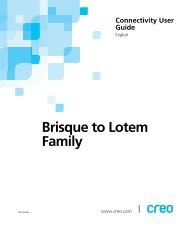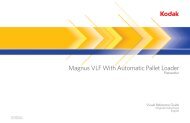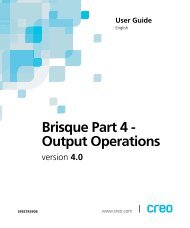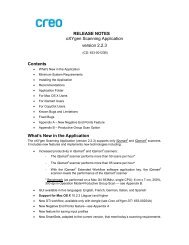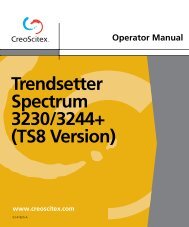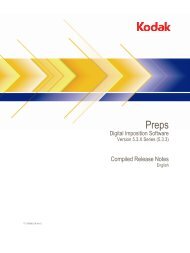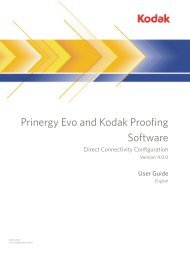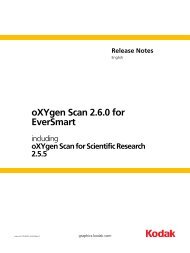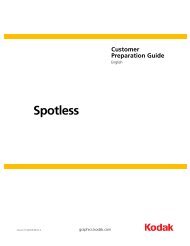Prinergy Evo and Kodak Proofing Software
Prinergy Evo and Kodak Proofing Software
Prinergy Evo and Kodak Proofing Software
Create successful ePaper yourself
Turn your PDF publications into a flip-book with our unique Google optimized e-Paper software.
<strong>Prinergy</strong> <strong>Evo</strong> <strong>and</strong> <strong>Kodak</strong> <strong>Proofing</strong><br />
<strong>Software</strong><br />
Direct Connectivity Configuration<br />
Version 4.2.0<br />
User Guide<br />
English<br />
2009-11-06<br />
734-00085B-EN-O-PR01
Copyright<br />
Trademarks<br />
FCC compliance<br />
© <strong>Kodak</strong>, 2009. All rights reserved.<br />
Some documentation is distributed in Portable Document Format (PDF). You may reproduce such documentation from<br />
the PDF file for internal use. Copies produced from the PDF file must be reproduced in whole.<br />
<strong>Kodak</strong>, Creo, Approval, Brisque, ColorFlow, eCentral, <strong>Evo</strong>, <strong>Kodak</strong> Veris, Matchprint, <strong>and</strong> <strong>Prinergy</strong> are trademarks of<br />
<strong>Kodak</strong>.<br />
Acrobat, Adobe, Distiller, Illustrator, Photoshop, <strong>and</strong> PostScript are trademarks of Adobe Systems Incorporated. Apple,<br />
AppleShare, AppleTalk, iMac, ImageWriter, LaserWriter, Mac OS, Power Macintosh, <strong>and</strong> TrueType are registered<br />
trademarks of Apple Inc. Macintosh is a trademark of Apple Inc., registered in the U.S.A. <strong>and</strong> other countries.<br />
Hexachrome, PANTONE, PANTONE Goe, PANTONE Hexachrome, <strong>and</strong> PANTONE MATCHING SYSTEM are the<br />
property of Pantone, Inc. PEARL, PEARLdry, PEARLgold, PEARLhdp, <strong>and</strong> PEARLsetter are registered trademarks of<br />
Presstek, Inc. XEROX is a trademark of XEROX CORPORATION.<br />
Any <strong>Kodak</strong> equipment referred to in this document complies with the requirements in part 15 of the FCC Rules for a<br />
Class A digital device. Operation of the <strong>Kodak</strong> equipment in a residential area may cause unacceptable interference to<br />
radio <strong>and</strong> TV reception, requiring the operator to take whatever steps are necessary to correct the interference.<br />
Equipment recycling<br />
In the European Union, this symbol indicates that when the last user wishes to discard this<br />
product, it must be sent to appropriate facilities for recovery <strong>and</strong> recycling.<br />
Contact your local <strong>Kodak</strong> representative or refer to http://www.kodak.com/go/recycle/ for<br />
additional information on the collection <strong>and</strong> recovery programs available for this product.<br />
REACH<br />
Please consult http://www.kodak.com/go/REACH for information about the presence of substances included on the<br />
c<strong>and</strong>idate list according to article 59(1) of Regulation (EC) No. 1907/2006 (REACH).<br />
Limitation of liability<br />
The product, software or services are being provided on an “as is” <strong>and</strong> “as available” basis. Except as may be stated<br />
specifically in your contract, <strong>Kodak</strong> expressly disclaims all warranties of any kind, whether express or implied, including,<br />
but not limited to, any implied warranties of merchantability, fitness for a particular purpose <strong>and</strong> non-infringement.<br />
You underst<strong>and</strong> <strong>and</strong> agree that, except as may be stated specifically in your contract, <strong>Kodak</strong> shall not be liable for any<br />
direct, indirect, incidental, special, consequential or exemplary damages, including but not limited to, damages for loss of<br />
profits, goodwill, use, data or other intangible losses (even if <strong>Kodak</strong> has been advised of the possibility of such damages),<br />
resulting from: (i) the use or the inability to use the product or software; (ii) the cost of procurement of substitute goods<br />
<strong>and</strong> services resulting from any products, goods, data, software, information or services purchased; (iii) unauthorized<br />
access to or alteration of your products, software or data; (iv) statements or conduct of any third party; (v) any other<br />
matter relating to the product, software, or services.<br />
The text <strong>and</strong> drawings herein are for illustration <strong>and</strong> reference only. The specifications on which they are based are<br />
subject to change. <strong>Kodak</strong> may, at any time <strong>and</strong> without notice, make changes to this document. <strong>Kodak</strong> assumes no<br />
liability for technical or editorial errors or omissions made herein, <strong>and</strong> shall not be liable for incidental, consequential,<br />
indirect, or special damages, including, without limitation, loss of use, loss or alteration of data, delays, or lost profits or<br />
savings arising from the use of this document.<br />
http://graphics.kodak.com/<br />
Internal 734-00085B-EN-O-PR01<br />
Revised 2009-11-06
Contents<br />
1 Introduction..........................................................................................................................................1<br />
Prerequisites....................................................................................................................................................................................1<br />
2 Setting up <strong>Kodak</strong> <strong>Proofing</strong> <strong>Software</strong>..............................................................................................3<br />
Enabling unlicensed demo mode...............................................................................................................................................3<br />
Downloading configuration files from eCentral....................................................................................................................3<br />
Installing configuration files.......................................................................................................................................................4<br />
Calibrating the proofer................................................................................................................................................................4<br />
Enabling <strong>and</strong> disabling Precision Color calibration......................................................................................................4<br />
Creating a calibration..........................................................................................................................................................5<br />
Uncalibrated printing ..........................................................................................................................................................5<br />
Creating a custom layout............................................................................................................................................................6<br />
Signing custom profiles...............................................................................................................................................................6<br />
Profile signing........................................................................................................................................................................6<br />
Sign Profile dialog box.........................................................................................................................................................7<br />
Signing profiles <strong>and</strong> applying a profile category (Administrator)...........................................................................8<br />
Re-signing profiles (Administrator)...............................................................................................................................10<br />
Sending profiles to <strong>Kodak</strong> for adding a logo................................................................................................................10<br />
Exporting ICC profiles.................................................................................................................................................................11<br />
3 Setting up <strong>Prinergy</strong> <strong>Evo</strong>...................................................................................................................13<br />
Downloading <strong>and</strong> importing PANTONE color library files...............................................................................................13<br />
PANTONE color libraries..................................................................................................................................................13<br />
Importing color library files..............................................................................................................................................13<br />
Adding proofers to <strong>Prinergy</strong> <strong>Evo</strong> Administrator..................................................................................................................14<br />
4 Setting up process templates without ColorFlow....................................................................17<br />
Copying ICC profiles to the <strong>Prinergy</strong> <strong>Evo</strong> server.................................................................................................................17<br />
Selecting a RIP..............................................................................................................................................................................17<br />
RIP choice..............................................................................................................................................................................17<br />
Selecting a RIP in <strong>Prinergy</strong> <strong>Evo</strong>........................................................................................................................................18<br />
Selecting a RIP in Open Connectivity Kit......................................................................................................................18<br />
Editing a refine to PDF template..............................................................................................................................................18<br />
Editing output from PDF templates........................................................................................................................................19<br />
5 Setting up ColorFlow.......................................................................................................................23<br />
Setting up ColorFlow for imported signed profiles............................................................................................................ 23<br />
Creating a color setup.......................................................................................................................................................23<br />
Creating a ColorFlow device...........................................................................................................................................24<br />
Defining a device condition.............................................................................................................................................24<br />
Using a custom reference device condition................................................................................................................ 25<br />
Creating an SCO.................................................................................................................................................................26<br />
Importing a device profile................................................................................................................................................ 26
vi<br />
<strong>Prinergy</strong> <strong>Evo</strong> <strong>and</strong> <strong>Kodak</strong> <strong>Proofing</strong> <strong>Software</strong> Direct Connectivity Configuration User Guide<br />
Importing a DeviceLink.....................................................................................................................................................27<br />
Taking a snapshot.............................................................................................................................................................. 27<br />
Approving a snapshot.......................................................................................................................................................28<br />
6 Setting up process templates with ColorFlow.........................................................................29<br />
Editing output from PDF templates.......................................................................................................................................29<br />
7 Certified Process for Color Confirmation..................................................................................33<br />
<strong>Prinergy</strong> <strong>Evo</strong> settings that work with the Certified Process for Color Confirmation.................................................33<br />
More about profile names........................................................................................................................................................33<br />
8 Improved output for multiple Matchprint Inkjet proofers....................................................39<br />
Solutions for increasing <strong>Prinergy</strong> server output..................................................................................................................39<br />
Appropriate number of JTPs solution....................................................................................................................................39<br />
Render resolution solution.......................................................................................................................................................39<br />
Render resolution...............................................................................................................................................................39<br />
Setting the render resolution..........................................................................................................................................40<br />
Load balance solution...............................................................................................................................................................40<br />
Load balance.......................................................................................................................................................................40<br />
Setting up the load balance workaround......................................................................................................................41<br />
Using the load balance workaround..............................................................................................................................41
1<br />
Introduction<br />
Prerequisites<br />
This user guide describes how to set up the direct connectivity<br />
configuration of the <strong>Kodak</strong> ® <strong>Prinergy</strong> ® <strong>Evo</strong> software <strong>and</strong> <strong>Kodak</strong><br />
<strong>Proofing</strong> <strong>Software</strong> to output proofing jobs to a <strong>Kodak</strong> Matchprint ® Inkjet<br />
proofer. It also describes a setup with <strong>and</strong> without the <strong>Kodak</strong><br />
ColorFlow software.<br />
●<br />
●<br />
●<br />
●<br />
●<br />
●<br />
Contact your service representative about the required version of<br />
<strong>Prinergy</strong> <strong>Evo</strong> software.<br />
The <strong>Prinergy</strong> <strong>Evo</strong> software must have the following modules<br />
licensed, installed, <strong>and</strong> running:<br />
●<br />
●<br />
Proof Color Management (part number 632-00164A)<br />
<strong>Prinergy</strong> <strong>Evo</strong> <strong>Proofing</strong> Connectivity Kit (part number<br />
632-00167A)<br />
This document reflects <strong>Prinergy</strong> <strong>Evo</strong> 4.1.6.0.<br />
Basic operating knowledge of the <strong>Prinergy</strong> <strong>Evo</strong> software, particularly<br />
how to create a new process template. For information about<br />
working with <strong>Prinergy</strong> <strong>Evo</strong>, see the <strong>Prinergy</strong> <strong>Evo</strong> User Guide.<br />
<strong>Kodak</strong> <strong>Proofing</strong> <strong>Software</strong> 4.2.0 or later (This document reflects<br />
<strong>Kodak</strong> <strong>Proofing</strong> <strong>Software</strong> 4.2.0.)<br />
Matchprint Inkjet proofer installed <strong>and</strong> configured with a custom<br />
sheet layout (if you are not using a default layout)<br />
(Optional) ColorFlow software 1.0.6.0 or later (This document<br />
reflects ColorFlow 1.0.6.0.)
2 Chapter 1—Introduction
2<br />
Setting<br />
up <strong>Kodak</strong><br />
<strong>Proofing</strong> <strong>Software</strong><br />
Enabling unlicensed demo mode<br />
Demo mode is available for <strong>Kodak</strong> <strong>Proofing</strong> <strong>Software</strong> only when the<br />
software is unlicensed <strong>and</strong> lacks a dongle.<br />
When <strong>Kodak</strong> <strong>Proofing</strong> <strong>Software</strong> is in demo mode, you can add a<br />
supported proofer (if you have one) or add simulated proofers (if you<br />
don’t have a supported proofer), <strong>and</strong> use the <strong>Kodak</strong> <strong>Proofing</strong> <strong>Software</strong><br />
features. However, proofs print with a watermark, <strong>and</strong> simulated<br />
proofers only simulate printing (they do not print).<br />
After using demo mode, you can license <strong>Kodak</strong> <strong>Proofing</strong> <strong>Software</strong> <strong>and</strong><br />
start using proofers for production work. Proofs will no longer print with<br />
a watermark. For more information, see the <strong>Kodak</strong> <strong>Proofing</strong> <strong>Software</strong><br />
Help.<br />
1. In the Proofer Administrator, click the Controller icon, <strong>and</strong> click the<br />
License tab.<br />
2. Select the Demo mode check box.<br />
3. Click the Proofers tab, <strong>and</strong> click Add.<br />
4. In the Add Proofers dialog box, select Add proofer to this controller,<br />
<strong>and</strong> then click Next.<br />
5. Follow the prompts in the Add Proofer Wizard.<br />
Note: If you do not have a supported proofer model, add a simulated proofer.<br />
Simulated proofer names end with (Simulated).<br />
After you add a proofer, the Proofer Controller may restart.<br />
Downloading configuration files from eCentral<br />
ICC profiles, ICC device link profiles, <strong>and</strong> media configurations for<br />
Matchprint Inkjet proofers are posted on the <strong>Kodak</strong> eCentral portal.<br />
ICC profile, ICC device link profile, <strong>and</strong> media configuration downloads<br />
are packaged into configuration files for each proofer model. You can<br />
search, download, <strong>and</strong> install configuration files by proofer model.<br />
1. Go to eCentral (https://ecentral.kodak.com/).<br />
2. At the top of the navigation bar, click Self Support, <strong>and</strong> then click<br />
Downloads.<br />
3. In the Product list, select Matchprint Inkjet.<br />
4. In the Download Type list, select Configuration files, <strong>and</strong> click Go.
4 Chapter 2—Setting up <strong>Kodak</strong> <strong>Proofing</strong> <strong>Software</strong><br />
5. Click the proofer model, <strong>and</strong> locate the configuration file for the<br />
media that you want to use.<br />
Ensure that the media configuration file is compatible with your<br />
version of <strong>Kodak</strong> <strong>Proofing</strong> <strong>Software</strong>.<br />
6. Click the configuration file to download it.<br />
Installing configuration files<br />
If necessary, enter your <strong>Kodak</strong> user name <strong>and</strong> password.<br />
7. Save the configuration file to your desktop.<br />
Install configuration files in <strong>Kodak</strong> <strong>Proofing</strong> <strong>Software</strong> to add new files to<br />
your system or to update your system with the latest files.<br />
Do not manually extract <strong>and</strong> install the configuration files. You must<br />
use the following procedure to install them. Each time you add a new<br />
proofer to the system, you must reinstall the configuration files<br />
because they are excluded from the default settings.<br />
1. In Proofer Administrator, click the Controller icon, <strong>and</strong> click the<br />
<strong>Software</strong> tab.<br />
2. Click Install.<br />
Calibrating the proofer<br />
3. Locate the configuration file, select it, click Open, <strong>and</strong> then click<br />
Install.<br />
When the installation is complete, the installer displays a message that<br />
indicates the files were installed successfully.<br />
Enabling <strong>and</strong> disabling Precision Color calibration<br />
Use the Media Configuration Editor to enable <strong>and</strong> disable Precision<br />
Color calibration for a media configuration.<br />
Two calibration technologies are available: the new Precision Color <strong>and</strong><br />
the existing ColorZone. The Epson Stylus ® Pro 7900 printer <strong>and</strong> 9900<br />
printer can use only the Precision Color Calibration Wizard to calibrate<br />
the proofer. All other inkjet proofers can use the Precision Color<br />
Calibration Wizard or the ColorZone Calibration Wizard. Precision<br />
Color Calibration Wizard lets you optimize the calibration, but<br />
ColorZone Calibration Wizard does not.<br />
1. In Proofer Viewer, from the Configure menu, select Media<br />
Configuration.<br />
2. Select a media configuration, <strong>and</strong> click Edit.
Creating a calibration 5<br />
3. Click the Calibration tab, <strong>and</strong> perform one of the following actions:<br />
To<br />
Use Precision Color Calibration<br />
Wizard<br />
Use ColorZone Calibration Wizard<br />
Do this<br />
Select the Use Precision Color<br />
Calibration check box.<br />
Clear the Use Precision Color<br />
Calibration check box.<br />
Note: Some media configurations<br />
can use only Precision Color<br />
calibration. You cannot clear the Use<br />
Precision Color Calibration check<br />
box for these media configurations.<br />
Creating a calibration<br />
Uncalibrated printing<br />
4. Click Save.<br />
When you click the Calibrate button in the Calibration window in<br />
Proofer Viewer, <strong>Kodak</strong> <strong>Proofing</strong> <strong>Software</strong> starts the appropriate wizard.<br />
When Precision Color is enabled for a media configuration, the<br />
Precision Color Calibration Wizard starts. When Precision Color<br />
technology is disabled for a media configuration, the ColorZone<br />
Calibration Wizard starts.<br />
For best results, calibrate the proofer for the media configuration. You<br />
must calibrate the proofer to be able to use the Certified Process for<br />
Color Confirmation.<br />
The calibration process can take up to an hour or more, <strong>and</strong> the printer<br />
cannot perform any other function until calibration completes.<br />
Two calibration technologies are available—the existing ColorZone<br />
technology, <strong>and</strong> the new Precision Color technology. When you create<br />
a calibration, the appropriate technology is used. All media<br />
configuration files created with ColorZone technology can be<br />
converted to Precision Color technology if desired. Use the Media<br />
Configuration Editor to enable Precision Color technology for a media<br />
configuration.<br />
1. In Proofer Viewer, click Calibration.<br />
2. Select a media configuration.<br />
3. Click Calibrate.<br />
4. Follow the instructions in the Calibration wizard.<br />
You can use <strong>Kodak</strong> <strong>Proofing</strong> <strong>Software</strong> to print proofs without first<br />
calibrating the proofer for the media configuration. Uncalibrated<br />
proofers should not be used for color critical proofs. However, some<br />
proofs are not color critical <strong>and</strong> do not require a calibrated proofer.
6 Chapter 2—Setting up <strong>Kodak</strong> <strong>Proofing</strong> <strong>Software</strong><br />
Creating a custom layout<br />
Note: The Certified Process for Color Confirmation requires a proofer that is<br />
calibrated for the media configuration that is used to print the proof, <strong>and</strong> the<br />
calibration must be current, not expired.<br />
If none of the built-in layouts suit your needs, create a custom layout<br />
with the Layout Editor.<br />
1. In Proofer Viewer, from the Configure menu, select Layouts.<br />
2. Click New.<br />
3. Select the options as desired.<br />
4. Click Save.<br />
Signing custom profiles<br />
Do not use following characters in file names: + - / < > [ ] { } ? . ! @<br />
# $ % ^ & * ( ) = : ; ' "<br />
Profile signing<br />
Signed profiles are optional for all proofs, except proofs printed with<br />
the Certified Process for Color Confirmation. The Certified Process for<br />
Color Confirmation requires signed profiles. Signed profiles contain a<br />
digital seal to ensure that the profile has not been edited. When a<br />
profile is signed, you <strong>and</strong> your customers know:<br />
●<br />
●<br />
●<br />
A particular profile was used.<br />
Proofs made with the profile will always be printed using the correct<br />
paper.<br />
The profile was not changed since it was signed.<br />
Signed profiles come in two forms—<strong>Kodak</strong> profiles <strong>and</strong> custom<br />
profiles. <strong>Kodak</strong> profiles have gone through the <strong>Kodak</strong> quality assurance<br />
process. In Proofer Administrator, on the ICC Profiles tab, the origin of<br />
these profiles is <strong>Kodak</strong>.<br />
Custom profiles are the ones that you generate <strong>and</strong> sign in <strong>Kodak</strong><br />
<strong>Proofing</strong> <strong>Software</strong>. These profiles do not go through the <strong>Kodak</strong> quality<br />
assurance process. In Proofer Administrator, on the ICC Profiles tab,<br />
the origin of these profiles is Custom.<br />
The profiles provided by <strong>Kodak</strong> for each proofer media are created<br />
from a very large sample of media batches, ink batches, <strong>and</strong> proofers.<br />
As a result, they are much less likely to show color deviation than a<br />
custom profile created for one individual proofer based on one media<br />
batch <strong>and</strong> one ink batch. In order to maintain consistent color<br />
performance, it is strongly recommended that you use the <strong>Kodak</strong><br />
profiles that are delivered with the proofer. For the same reason, it is
Sign Profile dialog box 7<br />
Sign Profile dialog box<br />
strongly recommended that you use the <strong>Kodak</strong> proofer profile (also<br />
called a paper profile) when creating a device link.<br />
If you alter the contents of a profile, the digital signature will be broken<br />
<strong>and</strong> it will need to be re-signed. Changing the name of a profile does<br />
not affect the digital signature.<br />
What signing does <strong>and</strong> does not do to profiles<br />
The signing process adds some <strong>Kodak</strong>-specific tags to the existing<br />
profile <strong>and</strong> then seals it with a digital signature to ensure file integrity.<br />
These tags are compatible with the custom tagging specifications of<br />
the ICC, <strong>and</strong> do not alter the color characteristics of the profile in any<br />
way.<br />
Customizing your profile further with a logo<br />
If you want to include a logo on the caption for jobs printed with the<br />
Certified Process for Color Confirmation, you must submit the signed<br />
profile <strong>and</strong> logo to <strong>Kodak</strong> to sign again with the logo. The logo must be<br />
a TIFF image, <strong>and</strong> it is added to the profile during the signing process.<br />
You cannot add a logo to the profile when you use <strong>Kodak</strong> <strong>Proofing</strong><br />
<strong>Software</strong> to sign the profile. When you print a file using the Certified<br />
Process, the logo appears immediately to the right of the Certified logo<br />
on the caption, before any of the caption text. The requirements for the<br />
customer-supplied image are:<br />
● CMYK TIFF format, 8 bits per pixel, stripped (not tiled), separated,<br />
planar configuration<br />
● Stored at device resolution<br />
● LZW compression is strongly recommended. For example, the 1500<br />
dpi CCP logo is 2341 KB uncompressed, but only 65 KB when<br />
compressed using LZW.<br />
● Recommended size is maximum 0.5 in. (750 pixels) high × 0.5-1.0<br />
in. (750–1500 pixels) wide. The caption is optimized for 0.5 in.<br />
height, <strong>and</strong> making the custom logo any higher will increase the<br />
caption size <strong>and</strong> decrease the maximum image area available for<br />
the job.<br />
Media configuration<br />
Signs the selected custom profile <strong>and</strong> associates a media<br />
configuration with it. The signature includes the name of the<br />
selected media configuration.<br />
Select None to remove the media configuration association<br />
from a profile.
8 Chapter 2—Setting up <strong>Kodak</strong> <strong>Proofing</strong> <strong>Software</strong><br />
Profile category<br />
Signs the selected custom profile <strong>and</strong> assigns a category to it.<br />
The category determines which <strong>Kodak</strong> <strong>Proofing</strong> <strong>Software</strong> lists<br />
display the profile. (The profile must be enabled to display in a<br />
<strong>Kodak</strong> <strong>Proofing</strong> <strong>Software</strong> list.) Choose one of the following<br />
categories:<br />
Input: These profiles appear in the Input Color Space lists.<br />
Simulation: These profiles appear in the Simulation Color Space<br />
lists.<br />
Halftone Emulation: These profiles appear in the Halftone<br />
Profile list on the Simulation Color Space Advanced dialog box.<br />
Proofer: These profiles appear in the Proofer Color Space list.<br />
Select None to remove the category from a profile. These<br />
profiles appear in all unfiltered lists. In other words, they never<br />
show in filtered lists.<br />
Note: You can remove a signature from a profile. Select None in the Media<br />
configuration list <strong>and</strong> the Profile category list to remove the signature from a<br />
profile. Remember that you cannot use unsigned profiles with the Certified<br />
Process for Color Confirmation.<br />
Signing profiles <strong>and</strong> applying a profile category (Administrator)<br />
You can sign only custom profiles. You cannot sign <strong>Kodak</strong> profiles,<br />
because <strong>Kodak</strong> has already signed them.<br />
You sign custom profiles by selecting either a media configuration or a<br />
profile category or both. This topic describes the best way to sign<br />
profiles for use with the Certified Process for Color Confirmation.<br />
Note: The Certified Process for Color Confirmation requires signed profiles.<br />
1. In Proofer Administrator, click the Proofer icon, <strong>and</strong> click the ICC<br />
Profiles tab.<br />
2. Select the ICC profile, <strong>and</strong> click Sign.<br />
The Sign button is only available for custom profiles. On the ICC<br />
Profiles tab, custom profiles have an Origin of Custom.
Signing custom profiles 9<br />
3. Perform one of the following actions:<br />
For a profile that will be used as<br />
An input ICC profile<br />
Do this<br />
In the Profile category list, select<br />
Input. Do not select a media<br />
configuration for profiles that will<br />
be used as an input ICC profile<br />
because the media configuration<br />
name is not needed, <strong>and</strong> the media<br />
configuration name may limit how<br />
you can use the profile.<br />
Note: Input ICC profiles appear in<br />
the Input File Color Space lists.<br />
A simulation ICC profile<br />
A simulation device link profile<br />
A halftone emulation profile<br />
In the Profile category list, select<br />
Simulation. Do not select a media<br />
configuration for profiles that will<br />
be used as a simulation ICC profile<br />
because the media configuration<br />
name is not needed, <strong>and</strong> the media<br />
configuration name may limit how<br />
you can use the profile.<br />
In the Profile category list, select<br />
Simulation, <strong>and</strong> in the Media<br />
configuration list, select the media<br />
configuration that was used to<br />
create the profile.<br />
In the Profile category list, select<br />
Simulation, <strong>and</strong> in the Media<br />
configuration list, select the media<br />
configuration that was used to<br />
create the profile.<br />
Note: Halftone emulation profiles<br />
appear in the Halftone Profile list on<br />
the Simulation Color Space<br />
Advanced dialog box.<br />
A proofer profile<br />
All profiles<br />
In the Profile category list, select<br />
Proofer, <strong>and</strong> in the Media<br />
configuration list, select the media<br />
configuration that was used to<br />
create the profile.<br />
Select None in the Media<br />
configuration list <strong>and</strong> the Profile<br />
category list to remove the<br />
signature from a profile.<br />
Remember that you cannot use<br />
unsigned profiles with the Certified<br />
Process for Color Confirmation.<br />
Profiles without a category show in
10 Chapter 2—Setting up <strong>Kodak</strong> <strong>Proofing</strong> <strong>Software</strong><br />
For a profile that will be used as<br />
Do this<br />
all unfiltered lists. In other words,<br />
they never show in unfiltered lists.<br />
The terminology matches the options used on the ICC Profiles tab<br />
in the Open Connectivity Kit when you create hot folders or virtual<br />
printers.<br />
4. Click OK.<br />
Re-signing profiles (Administrator)<br />
When a hot folder, virtual printer, or color bar does not reference the<br />
custom profile, you can re-sign custom profiles or remove a signature<br />
from the custom profile.<br />
You can sign custom profiles by selecting either a media configuration,<br />
profile category, or both.<br />
Note: The Certified Process for Color Confirmation requires signed profiles.<br />
1. In Proofer Administrator, click the Proofer icon, <strong>and</strong> click the ICC<br />
Profiles tab.<br />
2. Select the ICC profile, <strong>and</strong> click Sign.<br />
The Sign button is only available for custom profiles. On the ICC<br />
Profiles tab, custom profiles have an Origin of Custom.<br />
3. Perform one of the following actions:<br />
To<br />
Re-sign a profile<br />
Remove a signature<br />
Do this<br />
In the Media configuration list,<br />
select a different media<br />
configuration, or in the Profile<br />
category list, select a different<br />
category.<br />
In the Media configuration list or<br />
the Profile category list, select<br />
None.<br />
4. Click OK.<br />
Sending profiles to <strong>Kodak</strong> for adding a logo<br />
<strong>Kodak</strong> can add a logo to a custom profile. The logo appears in the<br />
caption when you print jobs with the Certified Process for Color<br />
Confirmation. You cannot use Proofer Administrator to add a logo to a<br />
custom profile.<br />
1. Use Proofer Administrator to sign the custom profile.<br />
The signature captures the category <strong>and</strong> media configuration name<br />
(if applicable) for the profile.
Exporting ICC profiles 11<br />
2. Before you send the signed profile to <strong>Kodak</strong>, ensure that you have<br />
the following information for the profile:<br />
Information<br />
Target (press) or<br />
simulation profiles<br />
Output (proofer)<br />
profiles<br />
Customer name (will be used<br />
for archiving profiles)<br />
× ×<br />
Intended workflow/platform × ×<br />
Product family <strong>and</strong> version × ×<br />
Custom logo to embed if<br />
desired<br />
Specific media type for each<br />
profile<br />
× ×<br />
×<br />
Exporting ICC profiles<br />
3. Log a support call on the <strong>Kodak</strong> eCentral portal (https://<br />
ecentral.kodak.com/), or contact a service representative.<br />
The service representative will determine the best way for you to<br />
send your profiles to <strong>Kodak</strong>. The profiles are then signed with the<br />
logo <strong>and</strong> returned to you.<br />
4. Import the profile(s) into Proofer Administrator.<br />
5. Copy the profiles to the correct location in your workflow system.<br />
You can export an ICC profile or an ICC device link profile, <strong>and</strong> import<br />
it into <strong>Kodak</strong> <strong>Proofing</strong> <strong>Software</strong> or copy it to workflow software, such<br />
as Brisque or <strong>Prinergy</strong>. Alternately, you can export an ICC profile or an<br />
ICC device link profile <strong>and</strong> its usage description to produce a resource<br />
file that you can import only into <strong>Kodak</strong> <strong>Proofing</strong> <strong>Software</strong>.<br />
Note: Profiles provided by <strong>Kodak</strong> are signed.<br />
1. In Proofer Administrator, click the Proofer icon, <strong>and</strong> click the ICC<br />
Profiles tab.<br />
2. Select the ICC profile or the ICC device link profile that you want to<br />
export, <strong>and</strong> click Export.<br />
3. In the Export Profile dialog box, select how much information you<br />
want to include with the profile, <strong>and</strong> click OK.<br />
4. Locate the folder where you want to put the profile, <strong>and</strong> click Save.
12 Chapter 2—Setting up <strong>Kodak</strong> <strong>Proofing</strong> <strong>Software</strong>
3<br />
Setting<br />
up <strong>Prinergy</strong> <strong>Evo</strong><br />
Downloading <strong>and</strong> importing PANTONE color library<br />
files<br />
PANTONE color libraries<br />
<strong>Kodak</strong> <strong>Proofing</strong> <strong>Software</strong> includes several CMYK <strong>and</strong> L*a*b* color<br />
libraries. It also includes several CMYK PANTONE color libraries<br />
created for specific media <strong>and</strong> Epson Stylus Pro printers.<br />
The following table lists the CMYK color libraries that are available for<br />
the Epson Stylus Pro printers.<br />
For this printer And media Use this color<br />
library<br />
Epson Stylus Pro 4800,<br />
7800, <strong>and</strong> 9800<br />
Epson Stylus Pro 4880,<br />
7880, <strong>and</strong> 9880<br />
Epson Stylus Pro 7900<br />
<strong>and</strong> 9900<br />
<strong>Kodak</strong> Matchprint Pro<br />
SuperWhite Semi-Matte<br />
245<br />
<strong>Kodak</strong> Matchprint Pro<br />
Coated SM240P Type 1<br />
<strong>Kodak</strong> Matchprint Pro<br />
PressWhite Semi-Matte 210<br />
<strong>Kodak</strong> Matchprint Pro<br />
Coated SM240P Type 1<br />
<strong>Kodak</strong> Matchprint Pro<br />
Coated SM240P Type 1<br />
PANTONE CMYK<br />
Mx800 SW245*<br />
PANTONE CMYK<br />
Mx800 SM240 T1*<br />
PANTONE CMYK<br />
Mx800 PW210*<br />
PANTONE CMYK<br />
Mx880 SM240 T1*<br />
PANTONE CMYK<br />
Mx900 T1SM240P<br />
7x14**<br />
Importing color library files<br />
* The optimal media configuration resolution for the color library is 720<br />
x 720.<br />
** The optimal media configuration resolution for the color library is<br />
720 x 1440.<br />
You can use other media configuration resolutions as desired.<br />
1. Download the compressed file of the PANTONE color libraries from<br />
eCentral (https://ecentral.kodak.com/).
14 Chapter 3—Setting up <strong>Prinergy</strong> <strong>Evo</strong><br />
2. Extract the PANTONE color library files from the compressed file,<br />
<strong>and</strong> copy the files that you need to a shared folder on the <strong>Prinergy</strong><br />
<strong>Evo</strong> server.<br />
3. In the <strong>Prinergy</strong> <strong>Evo</strong> Client software, from the Configure menu,<br />
select Color Definitions.<br />
4. Click Import.<br />
5. Locate <strong>and</strong> select a PANTONE color library file, <strong>and</strong> click Import.<br />
If you want to give the library a name that's different from the .txt<br />
file name, type the new name in the Import as box.<br />
The new library appears in the Color Libraries box, under User<br />
Libraries.<br />
6. If necessary, import other color library files.<br />
Adding proofers to <strong>Prinergy</strong> <strong>Evo</strong> Administrator<br />
Before you can use a proofer, you must add it in the Select Veris/<br />
Matchprint Inkjet Proofers dialog box.<br />
Requirements: <strong>Prinergy</strong> <strong>Evo</strong> 3.1.6.3 or later<br />
<strong>Prinergy</strong> <strong>Evo</strong> detects all Matchprint Inkjet proofers on the network.<br />
When you have successfully added a proofer, it appears in the output<br />
from PDF, output from imposition, <strong>and</strong> output from Adobe ® PostScript ®<br />
process templates.<br />
1. In <strong>Prinergy</strong> <strong>Evo</strong> Administrator, click the Tools tab.<br />
2. Click Veris/Matchprint Proofers or <strong>Kodak</strong> Proofers, depending on<br />
your version of <strong>Prinergy</strong> <strong>Evo</strong>.<br />
3. In the Visible Veris/Matchprint Proofers or Visible <strong>Kodak</strong><br />
Proofers list, select one or more proofers, <strong>and</strong> click the right-arrow<br />
button.<br />
The proofers move to the Veris/Matchprint Proofers to Use or<br />
<strong>Kodak</strong> Proofers to Use list. Different versions of <strong>Prinergy</strong> <strong>Evo</strong> use<br />
different names for the lists.<br />
4. If the name of the proofer that you want does not appear in the<br />
Visible Veris/ Matchprint Proofers or Visible <strong>Kodak</strong> Proofers list,<br />
click Use, <strong>and</strong> type the IP address or the name of the proofer that<br />
you want to add.<br />
Sometimes a proofer fails to appear when the proofer is in a<br />
different subnet than <strong>Prinergy</strong> <strong>Evo</strong> Administrator.<br />
Note: When typing the name of a proofer, type its IP address <strong>and</strong>/or name<br />
correctly. Otherwise, the proofer will not correctly appear in the Process<br />
Template Editor.<br />
5. Click OK.<br />
6. In the information window, click OK.<br />
7. On the System tab, click Restart.
Adding proofers to <strong>Prinergy</strong> <strong>Evo</strong> Administrator 15<br />
8. In the <strong>Prinergy</strong> <strong>Evo</strong> Shutdown - Restarting dialog box, select Finish<br />
current processing before stopping <strong>Prinergy</strong> <strong>Evo</strong>, <strong>and</strong> click Restart<br />
Now.<br />
The restart process may take a few minutes. Warning messages<br />
appear if the server needs to disconnect the <strong>Prinergy</strong> <strong>Evo</strong> Client<br />
software.
16 Chapter 3—Setting up <strong>Prinergy</strong> <strong>Evo</strong>
4<br />
Setting<br />
up process<br />
templates without<br />
ColorFlow<br />
Copying ICC profiles to the <strong>Prinergy</strong> <strong>Evo</strong> server<br />
Selecting a RIP<br />
RIP choice<br />
Automatically copy all signed profiles from <strong>Kodak</strong> <strong>Proofing</strong> <strong>Software</strong>.<br />
Requirements: ICC profiles <strong>and</strong>/or ICC DeviceLink profiles have been<br />
exported from the Proofer Administrator.<br />
If you are using <strong>Kodak</strong> <strong>Proofing</strong> <strong>Software</strong> 3.2.0 or later with <strong>Prinergy</strong><br />
<strong>Evo</strong> 3.2.6.1 or later, a <strong>Kodak</strong> service representative can set up the<br />
<strong>Prinergy</strong> <strong>Evo</strong> software to automatically copy all signed profiles from<br />
<strong>Kodak</strong> <strong>Proofing</strong> <strong>Software</strong>. With this option enabled, you no longer need<br />
to manually copy signed profiles between the two systems. However,<br />
you still need to copy unsigned profiles.<br />
1. On the <strong>Prinergy</strong> <strong>Evo</strong> server, create a folder in the ICC-Profiles<br />
folder (for example, ICC-Profiles\Printer\)<br />
for the <strong>Kodak</strong> <strong>Proofing</strong> <strong>Software</strong> profiles.<br />
If the folder already exists, skip this step.<br />
Note: On <strong>Prinergy</strong> <strong>Evo</strong> servers, the ICC-Profiles folder is in the<br />
Pgy<strong>Evo</strong>Config share.<br />
2. Copy the ICC profiles <strong>and</strong> DeviceLink profiles to the ICC-Profiles<br />
\Printer\ folder.<br />
3. On the <strong>Prinergy</strong> <strong>Evo</strong> server, share the folder that contains the<br />
profiles so that you can access the folder from the <strong>Prinergy</strong> <strong>Evo</strong><br />
Client software.<br />
4. If you are using custom ICC profiles, copy the custom profiles to the<br />
<strong>Prinergy</strong> <strong>Evo</strong> server computer.<br />
Note: When you create custom ICC profiles <strong>and</strong> want to use them with a<br />
certified process, submit the profiles to <strong>Kodak</strong> for signing before copying them.<br />
<strong>Prinergy</strong> <strong>Evo</strong> 4.x or later lets you choose whether to use Adobe CPSI RIP<br />
or Adobe PDF Print Engine RIP when you create an output from PDF<br />
process template.<br />
<strong>Kodak</strong> <strong>Proofing</strong> <strong>Software</strong> with Open Connectivity Kit 3.2.2 or later also<br />
lets you choose between the two RIPs. Earlier versions of <strong>Kodak</strong><br />
<strong>Proofing</strong> <strong>Software</strong> with Open Connectivity Kit included only the Adobe
18 Chapter 4—Setting up process templates without ColorFlow<br />
Selecting a RIP in <strong>Prinergy</strong> <strong>Evo</strong><br />
CPSI RIP. For best results, for your production jobs, use the same RIP in<br />
your workflow software <strong>and</strong> in <strong>Kodak</strong> <strong>Proofing</strong> <strong>Software</strong> with Open<br />
Connectivity Kit.<br />
Note: <strong>Kodak</strong> <strong>Proofing</strong> <strong>Software</strong> with Open Connectivity Kit is a licensed feature.<br />
1. In the Process Template Editor, open an output from PDF process<br />
template.<br />
2. Exp<strong>and</strong> the Render section, <strong>and</strong> select a RIP.<br />
3. Set the remaining options as desired, <strong>and</strong> click Save.<br />
Selecting a RIP in Open Connectivity Kit<br />
1. In Proofer Viewer, from the Configure menu, select Hot Folders/<br />
Virtual Printers.<br />
2. Click New, or select a hot folder or virtual printer, <strong>and</strong> click Edit.<br />
3. Set the options as desired, <strong>and</strong> click Next.<br />
4. On the Input Files tab, in the PDF RIP area, select a RIP.<br />
5. Set the remaining options on the tabs as desired, <strong>and</strong> click Save.<br />
Editing a refine to PDF template<br />
This section assumes that input files contain spot colors <strong>and</strong> that the<br />
files will be printed as CMYK plus spot colors on press. For the best<br />
spot-color inkjet-proofing results, leave the spot colors defined as spot<br />
colors in the digital file, <strong>and</strong> color-manage the spot colors during proof<br />
output to allow the spot color recipe to take advantage of the gamut of<br />
the proofer. When a spot color is converted to a process color during<br />
the refine, it limits control of the color reproduction on the proof.<br />
1. In the Process Template Editor, open a refine process template.<br />
2. In the Generate box, select PDF.<br />
3. In the Normalize section, in the PDF 1.4 - 1.6 (Acrobat 5 - 7) list,<br />
select an option for h<strong>and</strong>ling transparent objects.<br />
4. In the Spot Color H<strong>and</strong>ling section, set the following options:<br />
● Select Don’t Map Spot Colors.<br />
● Select Autoresolve Spot Color Naming Conflicts, <strong>and</strong> select C in<br />
the Resolve to list.<br />
● Select Resolve Ambiguous Spot Color Definitions.<br />
● Select Look Up Recipe in Color Database.<br />
● In the User Library list, select None.<br />
● In the Factory list, select PANTONE CMYK 2000.<br />
● In the Convert to Destination Profile area, select a profile that<br />
represents the final output color space, such as
Editing output from PDF templates 19<br />
USWebCoatedSWOP.icc. The final output color space is usually<br />
the press color space.<br />
Note: The profile that you select here automatically appears in the Final<br />
Output Process Profile box in the Match Colors section. These profiles are<br />
always the same.<br />
5. In the Match Colors section, select Strip Embedded Profiles, <strong>and</strong><br />
select profiles for CMYK Images, CMYK Graphics, RGB Images,<br />
<strong>and</strong> RGB Graphics.<br />
Note: When you select Strip Embedded Profiles but fail to select any profiles<br />
in the process template, <strong>Prinergy</strong> <strong>Evo</strong> strips any embedded profiles from the<br />
images <strong>and</strong> graphics in the input files but does not replace them, because no<br />
replacement profiles were identified in the process template.<br />
Note: <strong>Prinergy</strong> <strong>Evo</strong> does not support ICC profiles embedded in PostScript input<br />
files, because PostScript does not fully support embedded profiles.<br />
6. Set the remaining options as desired, <strong>and</strong> save the template.<br />
Editing output from PDF templates<br />
This procedure describes how to edit an output from PDF process<br />
template for inkjet proofing. For information about other <strong>Prinergy</strong> <strong>Evo</strong><br />
features, see the <strong>Prinergy</strong> <strong>Evo</strong> User Guide.<br />
This procedure assumes that a job will be printed as CMYK plus spot<br />
colors on press <strong>and</strong> describes how to best h<strong>and</strong>le spot colors. It<br />
describes how to use color libraries <strong>and</strong> ICC profiles to simulate the<br />
spot colors in digital files on inkjet proofs. Submitting files with CMYK<br />
plus spot colors to the proofer is key to the workflow settings<br />
described next <strong>and</strong> provides you with the best options for spot color<br />
h<strong>and</strong>ling.<br />
In <strong>Kodak</strong> <strong>Proofing</strong> <strong>Software</strong>, ensure that the resources you want to use<br />
in the following list are enabled:<br />
●<br />
●<br />
●<br />
●<br />
●<br />
Media configuration files<br />
Layouts<br />
ICC profiles<br />
ICC device link profiles<br />
Color bars<br />
Note: For the Matchprint Inkjet 400 <strong>and</strong> 800 proofing solution with HP ®<br />
Designjet ® printers, you can improve processing speeds by setting the render<br />
resolution.<br />
1. In the Process Template Editor, open a default process template.<br />
2. In the Output To list, select <strong>Kodak</strong> Proofers (KPS direct connect).
20 Chapter 4—Setting up process templates without ColorFlow<br />
3. In the Device section of the process template, set the following<br />
options:<br />
●<br />
●<br />
In the Proofer Name list, select the name of the proofer.<br />
In the Proofer Model list, select the name of the proofer model.<br />
Some versions of software automatically display the proofer<br />
model in this list.<br />
4. In the Layout section, set the following options:<br />
●<br />
●<br />
In the Media Configuration list, select the appropriate proofer<br />
media.<br />
In the Proofer Layout or Layout for <strong>Kodak</strong> Proofers list, select a<br />
<strong>Kodak</strong> <strong>Proofing</strong> <strong>Software</strong> layout.<br />
●<br />
Note: If you use the Certified Process for Color Confirmation, select the<br />
<strong>Kodak</strong> <strong>Proofing</strong> <strong>Software</strong> layout with the Certified Process for Color<br />
Confirmation enabled.<br />
In the Style area for N-Up, in the Number of Pages Across <strong>and</strong><br />
Down boxes, type 1.<br />
Note: This option is unavailable when you are setting up an output from<br />
imposition process template.<br />
The Proofer Layout or Layout for <strong>Kodak</strong> Proofers list displays the<br />
enabled layouts in <strong>Kodak</strong> <strong>Proofing</strong> <strong>Software</strong>. The Media<br />
Configuration list displays the enabled media configurations in<br />
<strong>Kodak</strong> <strong>Proofing</strong> <strong>Software</strong>. For more information, see the <strong>Kodak</strong><br />
<strong>Proofing</strong> <strong>Software</strong> User Guide.<br />
If the imposition is smaller than a sheet’s imageable area, select a 1-<br />
up layout. If the imposition is larger, select a tiled layout. For<br />
information about using layouts for double-sided media with<br />
Matchprint Inkjet proofers, see the <strong>Kodak</strong> <strong>Proofing</strong> <strong>Software</strong> User<br />
Guide.<br />
If you are outputting imposition files (PJTF or JDF), the layout is<br />
determined in your imposition software (for example, the <strong>Kodak</strong><br />
Preps ® digital imposition software or the <strong>Kodak</strong> P<strong>and</strong>ora ® step-<strong>and</strong>repeat<br />
software), but it is limited to the proofer sheet size. That is<br />
why you must select a 1-up or tiled proofing layout for imposition<br />
files.<br />
5. In the Render section, set the following options:<br />
●<br />
●<br />
In the Resolution X <strong>and</strong> Resolution Y boxes, confirm that the<br />
resolution matches the resolution of the proofer that you are<br />
sending proofs to. If it does not, select a different media<br />
configuration in the Layout section.<br />
In the Spot Color H<strong>and</strong>ling list, select Convert to Process.I<br />
6. In the Match Colors section, set the following options:<br />
For descriptions of ICC profiles, which you’ll need for every proofing<br />
process, see the description in <strong>Prinergy</strong> or the description in the
Editing output from PDF templates 21<br />
Proofer Administrator, where all ICC profiles are listed <strong>and</strong><br />
described.<br />
●<br />
For Profile, Select As defined below. Locate the ICC Profiles<br />
folder, <strong>and</strong> select the source or DeviceLink profile that matches<br />
the color space you are simulating.<br />
Note: If you are using the Certified Process for Color Confirmation, ensure<br />
that it is a signed profile. All default profiles are signed.<br />
●<br />
●<br />
●<br />
Note: When you select Refine Final Output Profile, <strong>Prinergy</strong> <strong>Evo</strong> uses the<br />
destination profile (if there is one) from the refine process template as the<br />
source profile.<br />
For Proof Profile, locate the ICC Profiles folder, <strong>and</strong> select a<br />
profile that matches the device, media, resolution, <strong>and</strong> ink that<br />
you’re using.<br />
Note: If you are using the Certified Process for Color Confirmation, ensure<br />
that it is a signed profile. All default profiles are signed.<br />
In the Rendering Intent list, select a rendering intent.<br />
In the Overprint H<strong>and</strong>ling (CPU Intensive) list, select Raster.<br />
Note: It is important to select this option to optimize the color<br />
management of files. However, processing time will increase when this<br />
option is selected.<br />
7. In the Spot Color H<strong>and</strong>ling section, set the following options:<br />
a. Select Lookup Recipe in Color Database to replace spot colors<br />
with known reliable color recipes. If the software can’t find those<br />
recipes, it uses the recipes in the file.<br />
b. Select a color library. If the color libraries that you need are<br />
included in <strong>Prinergy</strong> <strong>Evo</strong>, select them in the Factory Libraries list.<br />
If you imported the color libraries you need, select them in the<br />
User Libraries list. In a list that doesn’t contain the color libraries<br />
you need, select None.<br />
8. Save the process template with a meaningful name that includes the<br />
proofer name (if the site has more than one proofer), media type,<br />
simulation space, <strong>and</strong> proofing process—for example, MPI-001-<br />
COM-MP-Certified.<br />
9. Create a submission channel (hot folder or virtual printer), <strong>and</strong><br />
attach this process template to it. For information about submission<br />
channels, see the <strong>Prinergy</strong> User Guide.
22 Chapter 4—Setting up process templates without ColorFlow
5<br />
Setting<br />
up ColorFlow<br />
Setting up ColorFlow for imported signed profiles<br />
Creating a color setup<br />
Note: If you are not using ColorFlow software with <strong>Prinergy</strong> or <strong>Prinergy</strong> <strong>Evo</strong>, you<br />
can skip this step.<br />
Create a color setup <strong>and</strong> import the signed profiles into the ColorFlow<br />
software to complete the color setup.<br />
1. In ColorFlow, add a new color setup, <strong>and</strong> type the color setup name.<br />
For example, if you are targeting FOGRA 39, type Fogra 39 as the<br />
color setup name.<br />
2. In the Devices dialog box, drag a device to the primary color output<br />
(PCO) position.<br />
For example, drag CMYK Reference to the PCO position.<br />
3. Define the PCO device condition.<br />
4. Import a signed ICC profile as the device profile for the PCO device<br />
condition.<br />
For example, in the Device Condition Properties dialog box of the<br />
CMYK Reference device, in the Name list, select Fogra 39.<br />
5. Add a proofer to the secondary color output (SCO) position.<br />
6. Define the SCO device condition.<br />
7. Import a signed ICC profile as the device profile for the SCO device<br />
condition.<br />
For example, import a profile that converts Fogra 39 to the<br />
destination space of your proofer paper.<br />
8. Import a signed device link profile for the PCO-to-SCO conversion.<br />
9. Capture <strong>and</strong> approve a snapshot to make the elements of the color<br />
setup available to the <strong>Prinergy</strong> or <strong>Prinergy</strong> <strong>Evo</strong> workflow.<br />
Add a new, empty color setup to the Color Setups list to start a new<br />
color setup.<br />
1. In the Color Setups list, click the add button .<br />
Note: If you are starting ColorFlow for the first time, an empty color setup<br />
automatically appears in the Color Setups list.<br />
The Devices dialog box appears <strong>and</strong> a new empty color setup named<br />
Untitled_ appears in the Color Setups list.
24 Chapter 5—Setting up ColorFlow<br />
Creating a ColorFlow device<br />
Defining a device condition<br />
2. Double-click Untitled_, <strong>and</strong> type a new name for the color<br />
setup.<br />
3. Create the PCO device condition.<br />
Add a device to represent a physical device in your shop.<br />
1. Select View > Devices.<br />
Tip: You can double-click anywhere in the color setup viewer, outside the<br />
color setup, to open the Devices dialog box.<br />
The Devices dialog box appears.<br />
2. Exp<strong>and</strong> the Add Device section.<br />
3. In Device Name box, type a name for the device you want to add.<br />
4. In the Device Type list, select the device type.<br />
5. Click Create.<br />
The new device appears In the Devices section.<br />
Before you can determine the color response of this device, you must<br />
define its device condition.<br />
Select device condition properties to create a new device condition or<br />
to use an existing device condition.<br />
1. In the color setup viewer, click the Properties icon in a device<br />
condition.<br />
2. In the Device Condition Properties dialog box, select the appropriate<br />
options for your device type:<br />
Different options are available depending on your device type.<br />
Plate Setup<br />
Screening<br />
Select a plate setup from the list. The list is filtered to display<br />
plate setups for offset device types. Click the edit icon to<br />
display the Plate Setups dialog box, where you can add or<br />
edit a plate setup.<br />
Resolution<br />
Select the type of screening used in this device condition.<br />
You can select the type of screening only if you did not<br />
select a plate setup. If you need to add more values, click the<br />
edit button.<br />
Select the resolution used in this device condition (inkjet<br />
only). If you need to add more values, click the edit button.
Using a custom reference device condition 25<br />
Substrate<br />
Other<br />
Spot inks<br />
3. Click OK.<br />
Select the type of paper or substrate used in this device<br />
condition. The list is filtered based on the device type. If you<br />
need to add more values, click the edit button.<br />
Enter additional information that makes the device condition<br />
distinct from similar device conditions. To add your own<br />
values, click the edit button.<br />
Enables you to designate the process ink channel from which<br />
the workflow copies the calibration curve for each spot color.<br />
The ink named "Default" will be used for unnamed spot inks.<br />
Click the add button to add any number of inks. Click<br />
under Curve to assign one of the process channels. Click<br />
under Color to choose a suitable color (for visual recognition<br />
only). Click under Name to enter the name of the spot ink.<br />
If you selected a unique combination of properties, ColorFlow creates a<br />
new device condition. If you selected a combination of properties that<br />
can be found in an existing device condition for this device, ColorFlow<br />
uses that device condition. If the device is a curve-controlled device,<br />
<strong>and</strong> you selected a combination of properties that is already used by a<br />
device of the same type, ColorFlow pools both devices into the same<br />
device condition.<br />
Next:<br />
If you created a new device condition, you must establish the color<br />
response of the device condition. If the device condition contains a<br />
curve-controlled device, you must select a device curve to use when<br />
printing a chart to establish the color response of the device condition.<br />
Using a custom reference device condition<br />
Create a reference device condition that uses a color response that you<br />
supply.<br />
1. Drag CMYK Reference from the Devices dialog box to the color<br />
setup viewer:<br />
●<br />
●<br />
To create output that aligns to this color response, drag the<br />
device to the PCO position.<br />
To specify that input files should be re-separated to the color<br />
space of this color response, drag the device to the CI position.<br />
2. In the color setup viewer, click the Properties icon in the CMYK<br />
Reference device condition.
26 Chapter 5—Setting up ColorFlow<br />
3. In the Name list, type a name for the reference device condition.<br />
4. In the Separate Same As list, select a device type that best<br />
represents the black generation strategy of the reference device<br />
condition.<br />
For example, if your reference device condition uses the US<br />
Sheetfed v2 color response, select Offset Press - Sheetfed.<br />
5. Characterize the reference device condition.<br />
You can measure a chart or import existing measurements.<br />
The reference device condition you created is now available in the list<br />
of simulation targets.<br />
Creating an SCO<br />
Add an SCO to a color setup.<br />
Importing a device profile<br />
1. Select View > Devices.<br />
Tip: You can double-click anywhere in the color setup viewer, outside the<br />
color setup, to open the Devices dialog box.<br />
The Devices dialog box appears.<br />
2. Drag a device from the Devices dialog box to the SCO position in<br />
the color setup viewer.<br />
3. Define the device condition for the SCO device.<br />
Next: You can add additional SCOs to a color setup at any time. After<br />
you define a device condition for the SCO, establish the PCO-to-SCO<br />
conversion method.<br />
Use a device profile that was generated outside of ColorFlow.<br />
Note: If the device condition already has a color response that was derived from<br />
measurement data, importing a profile will not replace this color response.<br />
1. In a color setup in the color setup viewer, perform one of the<br />
following actions:<br />
● To import a profile for a device condition, click the Profile icon<br />
in the device condition.<br />
● To import a profile for the PCO, click the Profile icon in the<br />
PCO.<br />
If you clicked the Profile icon in a device condition, the Device<br />
Condition Profile dialog box appears. If you clicked the Profile icon<br />
in a PCO, the Primary Color Output Profile dialog box appears.<br />
2. In the Origin area, select Imported.<br />
3. Click the import button .
Importing a DeviceLink 27<br />
Importing a DeviceLink<br />
Taking a snapshot<br />
4. Locate the profile that you want to import, <strong>and</strong> click Open.<br />
Information about the profile that you selected is displayed.<br />
5. Click OK.<br />
Use a DeviceLink profile that was generated outside of ColorFlow.<br />
1. In a color setup in the color setup viewer, perform one of the<br />
following actions:<br />
●<br />
●<br />
To import a DeviceLink for a simulation, click the Simulation<br />
icon in the PCO.<br />
To import a DeviceLink for a conversion, click the Conversion<br />
icon between the CI <strong>and</strong> the PCO or between the PCO <strong>and</strong> the<br />
SCO.<br />
If you clicked the Simulation icon in a PCO, the Simulation<br />
Definition dialog box appears. If you clicked a Conversion icon, the<br />
Conversion - Definition dialog box appears.<br />
2. Drag the DeviceLinks slider to the Import position.<br />
3. Click the import button .<br />
4. Locate the DeviceLink profile that you want to import, <strong>and</strong> click<br />
Open.<br />
Information about the DeviceLink that you selected is displayed.<br />
5. Click OK.<br />
Capture a snapshot of all color control elements in all color setups at<br />
this moment.<br />
Requirements: You must commit all the adjustments that you want to<br />
include in a snapshot before you can take the snapshot. You cannot<br />
take a snapshot when calculations are pending or in progress.<br />
1. Select View > Snapshots.<br />
2. Click Capture.<br />
The snapshot appears in a new row in the table. The table lists a<br />
sequential ID <strong>and</strong> the date <strong>and</strong> time when the snapshot was<br />
captured.<br />
3. To add a note about a snapshot, double-click in the Notes column<br />
of the snapshot.<br />
The ColorFlow elements that you captured in the snapshot are now<br />
available to the <strong>Prinergy</strong> workflow.<br />
Next: To set the elements in this snapshot to be the default elements in<br />
the <strong>Prinergy</strong> workflow, you must approve it.
28 Chapter 5—Setting up ColorFlow<br />
Approving a snapshot<br />
Set elements in a particular snapshot to be the default set of elements<br />
that are used in the <strong>Prinergy</strong> workflow.<br />
1. Select View > Snapshots.<br />
2. In the table, select the snapshot that you want to approve.<br />
3. Click Approve.<br />
This snapshot becomes the approved snapshot, <strong>and</strong> any snapshots<br />
taken before this snapshot are deleted.
6<br />
Setting<br />
up process<br />
templates with<br />
ColorFlow<br />
Editing output from PDF templates<br />
This procedure describes how to edit an output from PDF process<br />
template for inkjet proofing. For information about other <strong>Prinergy</strong> <strong>Evo</strong><br />
features, see the <strong>Prinergy</strong> <strong>Evo</strong> User Guide.<br />
This procedure assumes that a job will be printed as CMYK plus spot<br />
colors on press <strong>and</strong> describes how to best h<strong>and</strong>le spot colors. It<br />
describes how to use color libraries <strong>and</strong> ICC profiles to simulate the<br />
spot colors in digital files on inkjet proofs. Submitting files with CMYK<br />
plus spot colors to the proofer is key to the workflow settings described<br />
next <strong>and</strong> provides you with the best options for spot color h<strong>and</strong>ling.<br />
In <strong>Kodak</strong> <strong>Proofing</strong> <strong>Software</strong>, ensure that the resources you want to use<br />
in the following list are enabled:<br />
●<br />
●<br />
●<br />
●<br />
●<br />
Media configuration files<br />
Layouts<br />
ICC profiles<br />
ICC device link profiles<br />
Color bars<br />
Note: For the Matchprint Inkjet 400 <strong>and</strong> 800 proofing solution with HP Designjet<br />
printers, you can improve processing speeds by setting the render resolution.<br />
1. In the Process Template Editor, open a default process template.<br />
2. In the Output To list, select <strong>Kodak</strong> Proofers (KPS direct connect).<br />
3. In the Device section of the process template, set the following<br />
options:<br />
●<br />
●<br />
In the Proofer Name list, select the name of the proofer.<br />
In the Proofer Model list, select the name of the proofer model.<br />
Some versions of software automatically display the proofer<br />
model in this list.<br />
4. In the ColorFlow section, set the following options:<br />
●<br />
●<br />
●<br />
●<br />
●<br />
In the Snapshot list, select a ColorFlow snapshot.<br />
In the ColorSetups list, select a color setup.<br />
In the Device Name list, select the proofer.<br />
In the Device Condition list, select the device condition for the<br />
proofer.<br />
(Optional) In the Plate Line list, select the line of plates that you<br />
use on press.
30 Chapter 6—Setting up process templates with ColorFlow<br />
5. In the Layout section, set the following options:<br />
●<br />
●<br />
●<br />
In the Media Configuration list, select the appropriate proofer<br />
media.<br />
In the Proofer Layout or Layout for <strong>Kodak</strong> Proofers list, select a<br />
<strong>Kodak</strong> <strong>Proofing</strong> <strong>Software</strong> layout.<br />
Note: If you use the Certified Process for Color Confirmation, select the<br />
<strong>Kodak</strong> <strong>Proofing</strong> <strong>Software</strong> layout with the Certified Process for Color<br />
Confirmation enabled.<br />
In the Style area for N-Up, in the Number of Pages Across <strong>and</strong><br />
Down boxes, type 1.<br />
Note: This option is unavailable when you are setting up an output from<br />
imposition process template.<br />
The Proofer Layout or Layout for <strong>Kodak</strong> Proofers list displays the<br />
enabled layouts in <strong>Kodak</strong> <strong>Proofing</strong> <strong>Software</strong>. The Media<br />
Configuration list displays the enabled media configurations in<br />
<strong>Kodak</strong> <strong>Proofing</strong> <strong>Software</strong>. For more information, see the <strong>Kodak</strong><br />
<strong>Proofing</strong> <strong>Software</strong> User Guide.<br />
If the imposition is smaller than a sheet’s imageable area, select a 1-<br />
up layout. If the imposition is larger, select a tiled layout. For<br />
information about using layouts for double-sided media with<br />
Matchprint Inkjet proofers, see the <strong>Kodak</strong> <strong>Proofing</strong> <strong>Software</strong> User<br />
Guide.<br />
If you are outputting imposition files (PJTF or JDF), the layout is<br />
determined in your imposition software (for example, the <strong>Kodak</strong><br />
Preps digital imposition software or the <strong>Kodak</strong> P<strong>and</strong>ora step-<strong>and</strong>repeat<br />
software), but it is limited to the proofer sheet size. That is<br />
why you must select a 1-up or tiled proofing layout for imposition<br />
files.<br />
6. In the Render section, set the following options:<br />
●<br />
●<br />
In the Resolution X <strong>and</strong> Resolution Y boxes, confirm that the<br />
resolution matches the resolution of the proofer that you are<br />
sending proofs to. If it does not, select a different media<br />
configuration in the Layout section.<br />
In the Spot Color H<strong>and</strong>ling list, select Convert to Process.I<br />
7. In the Match Colors section, set the following options:<br />
The ColorFlow color setup replaces the profile selections.<br />
●<br />
In the Overprint H<strong>and</strong>ling (CPU Intensive) list, select Raster.<br />
Note: It is important to select this option to optimize the color<br />
management of files. However, processing time will increase when this<br />
option is selected.
Editing output from PDF templates 31<br />
8. In the Spot Color H<strong>and</strong>ling section, set the following options:<br />
a. Select Lookup Recipe in Color Database to replace spot colors<br />
with known reliable color recipes. If the software can’t find those<br />
recipes, it uses the recipes in the file.<br />
b. Select a color library. If the color libraries that you need are<br />
included in <strong>Prinergy</strong> <strong>Evo</strong>, select them in the Factory Libraries list.<br />
If you imported the color libraries you need, select them in the<br />
User Libraries list. In a list that doesn’t contain the color libraries<br />
you need, select None.<br />
9. Save the process template with a meaningful name that includes the<br />
proofer name (if the site has more than one proofer), media type,<br />
simulation space, <strong>and</strong> proofing process—for example, MPI-001-<br />
COM-MP-Certified.<br />
10.Create a submission channel (hot folder or virtual printer), <strong>and</strong><br />
attach this process template to it. For information about submission<br />
channels, see the <strong>Prinergy</strong> User Guide.
32 Chapter 6—Setting up process templates with ColorFlow
7<br />
Certified<br />
Process for<br />
Color Confirmation<br />
<strong>Prinergy</strong> <strong>Evo</strong> settings that work with the Certified<br />
Process for Color Confirmation<br />
More about profile names<br />
If you are using the Certified Process for Color Confirmation, the<br />
following options in the <strong>Prinergy</strong> <strong>Evo</strong> process template work together:<br />
●<br />
●<br />
●<br />
Media Configuration in the Layout section<br />
Proof Profile in the Match Colors section<br />
Profile in the Match Colors section<br />
For the Certified Process for Color Confirmation, Extra Margins for<br />
Marks <strong>and</strong> Bleed must be set to 0 in the Left, Right, Top, <strong>and</strong> Bottom<br />
boxes to allow the color bar to be processed.<br />
Each media is associated with a default proof ICC profile. Each proof<br />
profile can work with a number of ICC DeviceLink profiles. Use the<br />
naming conventions of ICC profiles <strong>and</strong> ICC DeviceLink profiles to<br />
identify which profiles are associated with each media.<br />
Note: When you use ColorFlow software with <strong>Prinergy</strong> <strong>Evo</strong>, ColorFlow software<br />
controls the profiles for the process templates.<br />
A naming convention is used for default ICC profiles <strong>and</strong> default ICC<br />
device link profiles for Matchprint Inkjet proofers. The name provides<br />
information about the contents of the ICC profile <strong>and</strong> the ICC device<br />
link profile.<br />
Profile names for Matchprint Inkjet proofers<br />
Profiles for Matchprint Inkjet proofers are named according to two<br />
methodologies. The following table describes the old <strong>and</strong> new profile<br />
naming methods.
34 Chapter 7—Certified Process for Color Confirmation<br />
Type of profile Old naming convention New naming convention<br />
ICC<br />
ICC device link<br />
+ + + , if necessary +<br />
> + <br />
+ + .icc<br />
+ + + , if necessary +<br />
> + <br />
+ + + +<br />
.dvl<br />
+ +<br />
, if necessary +<br />
or + , if space permits +<br />
+<br />
+ .icc<br />
+ +<br />
, if necessary +<br />
or + + ,<br />
if space permits + + + .dvl<br />
Note: Profiles for Epson Stylus Pro printers identify the resolution, <strong>and</strong> profiles for<br />
HP Designjet Z2100 printers identify the imaging setting.<br />
You can determine which media configuration <strong>and</strong> ICC profiles are<br />
associated with each other by matching the following elements:<br />
●<br />
●<br />
●<br />
Device name <strong>and</strong> model<br />
Paper abbreviation<br />
Resolution or imaging setting<br />
The matching elements are used in the file name of the associated<br />
proof ICC profile <strong>and</strong> ICC device link profile to indicate that they work<br />
together.<br />
Definitions of elements in profile names<br />
The following table defines the elements of the new naming<br />
convention.
More about profile names 35<br />
Element<br />
<br />
Description<br />
: Hewlett-Packard Designjet Z2100<br />
: Epson Stylus Pro 4000<br />
: Epson Stylus Pro 7600, 9600<br />
: Epson Stylus Pro 7700 <strong>and</strong> 9700<br />
: Epson Stylus Pro 4800, 7800, 9800<br />
: Epson Stylus Pro 4880, 7880, 9880<br />
: Epson Stylus Pro 7900, 9900<br />
: Epson Stylus Pro 10600<br />
: Matchprint 2610<br />
Note: indicates Matchprint Inkjet.<br />
<br />
<br />
<br />
(for Epson Stylus Pro<br />
printers)<br />
: Two-sided<br />
: Commercial<br />
: Glossy<br />
: Matte<br />
: Publication<br />
: PressWhite<br />
: Satin<br />
: Semi-Matte<br />
: SuperWhite<br />
Media names may combine several media<br />
abbreviations. For example, CSM285 indicates Pro<br />
Commercial Semi-Matte 285 media.<br />
: Epson UltraChrome ® ink or HP Z2100 Vivera ink<br />
: 1440 dpi × 720 dpi<br />
or : 1200 dpi × 1200 dpi<br />
: 720 dpi × 720 dpi<br />
: 600 dpi × 600 dpi<br />
: 360 dpi × 360 dpi<br />
: Premium quality 12-pass uni-directional mode<br />
: High quality12-pass uni-directional mode<br />
: Premium quality 16-pass bi-directional mode<br />
: High quality 16-pass bi-directional mode<br />
: St<strong>and</strong>ard four-pass bi-directional mode<br />
: Matte four-pass bi-directional mode
36 Chapter 7—Certified Process for Color Confirmation<br />
Element<br />
<br />
(for HP Designjet<br />
Z2100 printers)<br />
<br />
<br />
<br />
Description<br />
: Premium quality imaging mode<br />
: High quality imaging mode<br />
: St<strong>and</strong>ard quality imaging mode<br />
: Matte quality imaging mode<br />
: Number of passes<br />
: Uni-directional mode<br />
: Bi-directional mode<br />
Imaging settings combine the quality imaging mode,<br />
the number of passes, <strong>and</strong> uni- or bi-directional<br />
printing. For example, P12u indicates premium quality<br />
imaging mode with 12 passes <strong>and</strong> uni-directional<br />
printing.<br />
Only used for device link profiles <strong>and</strong> profiles used for<br />
the halftone emulation feature. Indicates which source<br />
profile <strong>and</strong>/or color st<strong>and</strong>ard the device link profile<br />
simulates. A or<br />
naming convention is used.<br />
For example, may represent the<br />
following information:<br />
: Thermal Waterproof<br />
: Thermal Matchprint<br />
: SWOP ®<br />
: Fogra 23<br />
indicates the year that the st<strong>and</strong>ards<br />
organization obtained the characterization data.<br />
indicates an unfiltered spectrophotometer, <strong>and</strong><br />
indicates a UV-filtered (ultra-violet filtered)<br />
spectrophotometer. These characters appear only<br />
when both a U <strong>and</strong> a UV version of the profile exist.<br />
Indicates screen ruling in lpi or lcm. Screen ruling is<br />
included in profiles that are used for the halftone<br />
emulation feature.<br />
Indicates the version of the profile
More about profile names 37<br />
Element<br />
<br />
<br />
Description<br />
These are only used as needed.<br />
: Absolute colormetric rendering intent<br />
: Relative colormetric rendering intent<br />
: Perceptual colormetric rendering intent<br />
: Modified, indicates the paper tint was removed<br />
from the profile after it was created<br />
For or , see Source profile.<br />
These are only used as needed.<br />
: Indicates an unfiltered spectrophotometer was<br />
used to create the profile<br />
: Indicates a UV-filtered spectrophotometer was<br />
used to create the profile
38 Chapter 7—Certified Process for Color Confirmation
8<br />
Improved<br />
output for<br />
multiple Matchprint<br />
Inkjet proofers<br />
Solutions for increasing <strong>Prinergy</strong> server output<br />
If your <strong>Prinergy</strong> server struggles to keep multiple Matchprint Inkjet<br />
proofers running at full throughput, the following solutions can help<br />
increase the output:<br />
● Appropriate number of JTPs<br />
● Render resolution<br />
● Load balance<br />
The solutions are described in order of preference.<br />
Note: In <strong>Prinergy</strong>, disable the anti-aliasing feature to improve rendering time.<br />
Appropriate number of JTPs solution<br />
Render resolution solution<br />
Confirm with your Technical Support Specialist that you have the<br />
appropriate number of <strong>Prinergy</strong> JTPs for the Matchprint Inkjet proofing<br />
workload that you intend to process with your <strong>Prinergy</strong> software. Ask<br />
about the possibility of pooling your JTPs.<br />
An advantage of this solution is that you are using one piece of software<br />
(<strong>Prinergy</strong>) <strong>and</strong> one set of process templates to output proofs. Because<br />
of this, the risk of inconsistent settings is low. In addition, you are only<br />
using one RIP, <strong>and</strong> <strong>Prinergy</strong> supports the Certified Process for Color<br />
Confirmation.<br />
A disadvantage of this solution is that you must purchase each<br />
additional JTP.<br />
Render resolution<br />
Use the render resolution feature in <strong>Kodak</strong> <strong>Proofing</strong> <strong>Software</strong> 3.1.5.25,<br />
3.1.72, 3.2.0, or later to allow faster processing <strong>and</strong> transfer speeds.<br />
This feature lets you lower the render resolution for a media<br />
configuration without changing the resolution at which it will print on<br />
the proofer. For example, for a media configuration that uses a 1440 x<br />
720 resolution, you can request that <strong>Prinergy</strong> render it at a 360 x 360<br />
resolution. With the smaller render resolution, <strong>Prinergy</strong> can render the<br />
job faster <strong>and</strong> quickly pass the rendered job to <strong>Kodak</strong> <strong>Proofing</strong><br />
<strong>Software</strong>, where it is upsampled to the actual resolution (1440 x 720 in
40 Chapter 8—Improved output for multiple Matchprint Inkjet proofers<br />
Setting the render resolution<br />
Load balance solution<br />
Load balance<br />
this case) required by the media configuration for imaging on the<br />
proofer.<br />
An advantage of this solution is that it allows faster processing time in<br />
<strong>Prinergy</strong> <strong>and</strong> faster download time between <strong>Prinergy</strong> <strong>and</strong> <strong>Kodak</strong><br />
<strong>Proofing</strong> <strong>Software</strong>.<br />
A disadvantage of this solution is that linework <strong>and</strong> text may appear<br />
coarse on proofs.<br />
1. In <strong>Kodak</strong> <strong>Proofing</strong> <strong>Software</strong>, open the Proofer Viewer.<br />
2. In Proofer Viewer, from the Configure menu, select Media<br />
Configuration.<br />
3. Select a media configuration, <strong>and</strong> click Edit.<br />
4. In the Render Resolution list, select the render resolution that you<br />
want, <strong>and</strong> click Done.<br />
This change does not affect the name of the media configuration.<br />
However, when you select the media configuration in a <strong>Prinergy</strong><br />
process template, you can see the render resolution in the Render<br />
section.<br />
For example, if you set a 1440 x 720 media configuration to render<br />
at a 360 x 360 resolution in <strong>Kodak</strong> <strong>Proofing</strong> <strong>Software</strong>, you will see<br />
360 x 360 in the Resolution options in the Render section of the<br />
process template in <strong>Prinergy</strong> Workshop, even though you selected<br />
the 1440 x 720 media configuration in the Layout section of the<br />
process template.<br />
Share the workload between <strong>Prinergy</strong> <strong>and</strong> <strong>Kodak</strong> <strong>Proofing</strong> <strong>Software</strong><br />
with Open Connectivity Kit.<br />
Use <strong>Prinergy</strong> to generate refined PDF files, <strong>and</strong> submit the files to a hot<br />
folder for <strong>Kodak</strong> <strong>Proofing</strong> <strong>Software</strong> with Open Connectivity Kit to colormanage<br />
<strong>and</strong> to output on a Matchprint Inkjet proofer.<br />
An advantage of this solution is that it moves some of the processing<br />
burden from <strong>Prinergy</strong> to <strong>Kodak</strong> <strong>Proofing</strong> <strong>Software</strong> with Open<br />
Connectivity Kit <strong>and</strong> frees <strong>Prinergy</strong> for other processing activities.<br />
A disadvantage of this solution is that it introduces the opportunity for<br />
incorrect settings because you use two software applications to<br />
process the job. For example, you must ensure that the same ICC<br />
profiles <strong>and</strong> color libraries are available in both <strong>Prinergy</strong> <strong>and</strong> <strong>Kodak</strong><br />
<strong>Proofing</strong> <strong>Software</strong> for the proofing process. It may also be possible that
Setting up the load balance workaround 41<br />
the <strong>Prinergy</strong> software <strong>and</strong> <strong>Kodak</strong> <strong>Proofing</strong> <strong>Software</strong> use different<br />
versions of the Adobe RIP, due to different software release schedules.<br />
Setting up the load balance workaround<br />
Using the load balance workaround<br />
1. In <strong>Prinergy</strong>, set up the refine process template.<br />
2. In <strong>Kodak</strong> <strong>Proofing</strong> <strong>Software</strong> with Open Connectivity Kit, create a hot<br />
folder.<br />
For instructions, in the <strong>Kodak</strong> <strong>Proofing</strong> <strong>Software</strong> Help, search for<br />
information about creating a hot folder for jobs with CMYK <strong>and</strong><br />
spot colors.<br />
Note: When you set up the process settings, on the ICC Settings tab, in the<br />
Input File Color Space area, click the Advanced button, <strong>and</strong> select the Raster<br />
Color Management check box.<br />
1. In <strong>Prinergy</strong>, use the refine process template that you created to<br />
refine the input files.<br />
2. In Job Manager, in the Pages view, perform one of the following<br />
actions:<br />
●<br />
●<br />
In the Pages section, select the PDF files that you want to<br />
publish.<br />
In the Page Set section, select the page set that you want to<br />
publish.<br />
3. From the File menu, select Publish to PDF File.<br />
4. In the Publish PDF Files dialog box, set the options as desired, <strong>and</strong><br />
click Save.<br />
The Publish PDF Files dialog box closes, <strong>and</strong> <strong>Prinergy</strong> publishes one<br />
or more PDF files, depending on the choices that you made.<br />
5. Copy the refined PDF files, <strong>and</strong> paste them into the hot folder that<br />
you created for <strong>Kodak</strong> <strong>Proofing</strong> <strong>Software</strong> with Open Connectivity<br />
Kit.
42 Chapter 8—Improved output for multiple Matchprint Inkjet proofers
Eastman <strong>Kodak</strong> Company<br />
343 State Street<br />
Rochester, NY 14650 U.S.A.<br />
© <strong>Kodak</strong>, 2009. All Rights Reserved.<br />
TM: <strong>Kodak</strong><br />
To learn more about solutions from <strong>Kodak</strong>, visit http://<br />
graphics.kodak.com.<br />
Subject to technical change without notice.




